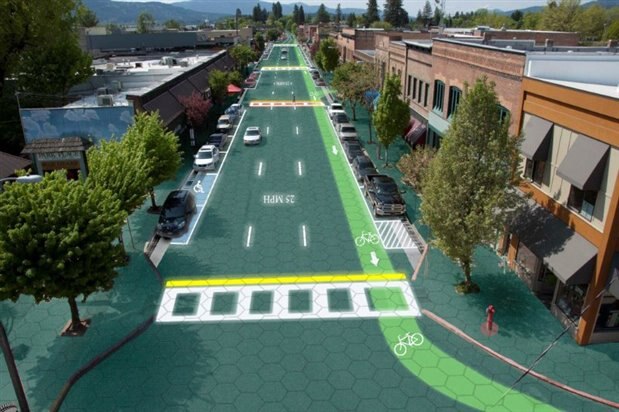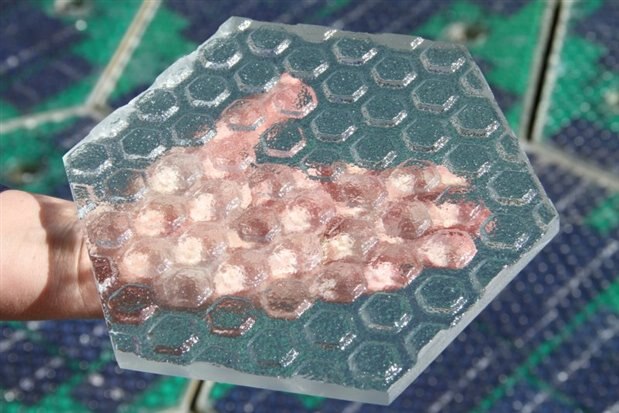Solar Roadways is looking to develop solar powered road panels for ‘smart highways.' (via Solar Roadways)
Solar power is just one of the alternative power resources countries are looking to capitalize on while weaning off fossil fuels. Arrays of solar panel fields are continuing to pop up all over the globe and scientists are developing ways to increase their efficiency in both converting and storing the suns energy using exotic materials (graphene and composite materials). We’ve all heard about incorporating solar collectors in windows that could be used to power the building their housed in or even solar-powered Wi-Fi (known as Green Wi-Fi) being developed by ITT.
So, what’s next for solar panel integration?
An Idaho-based tech start-up has the answer in terms of incorporating solar panels into the nation’s road and highway infrastructure. Solar Roadways (company name and project) are developing specialized solar panels that can be interconnected to each other essentially forming a ‘smart highway’, whose collected energy could be used to power nearby homes and businesses.
The idea is to replace existing petroleum-based paved roads and highways with transparent tiles outfitted with solar cells, sensors and electronics that have programming capabilities. If the hype rings true, the ‘Solar Road Panels’ will be able to withstand vehicles that weigh up to 250,000lbs., will virtually pay for themselves and could produce more ‘clean’ renewable energy than the nation consumes as a whole!
Wow, that’s quite a claim and all that’s missing is a set of free steak knives, however who needs cutlery when the modular panels will also feature built-in heating elements to melt snow and ice for safe commuting during the winter months. If that wasn’t enough (they remind me of Ron Popeil’s infomercials), they will also feature ‘Cable Corridors’ to collect and filter rain water as well as channel cabling for powering LED-based road signs and traffic signals. Like the infomercials, the ‘extras’ just keep coming- Once the Solar Roadway’s are in place, integrated mutual induction technology will charge EVs as people commute over the newly designed roadways!
Prototype glass translucent layer for the Solar Roadways project. (via Solar Roadways)
The panels are developed using three separate layers consisting of a translucent, high-strength surface that redirect sunlight at an optimum angle and are rough enough to provide traction.
The second layer consists of the panel’s electronics, including a microprocessor board to control the sensor suite (communications, monitoring and signage) as well as the heating coils for snow/ice melting and the solar cells.
The third layer acts as the power and data hub where the collected energy and relevant data are transferred, including homes and businesses.
Funding for the Solar Roadways smart highway was done through the crowd-funding site Indiegogo with an initial goal of $1-million and surpassing that goal to $1.9-million only a few days later. So, what is the money going towards and exactly how much does each individual tile cost? The answer isn’t that clear, Scott and Julie Brusaw (the brains behind Solar Roadways) received $100,000 in funding to build a prototype parking lot to test the concept from the DOT (Department of Transportation) back in 2009 (unknown where the money went).
In 2011, they received another grant from the DOT for $750,000 to build a prototype parking lot using their smart tiles. This resulted in the building of a 12 X 36ft prototype parking lot for a sum total of $850,000.
The couple also won a $50,000 community award for the most votes in GE’s Ecomagination challenge in 2010 for their ‘Powering the Grid’ project.
To put that into perspective, that’s $2.8-million so far in funding and their Indigogo drive still has two weeks to go, which has yet only resulted in the creation of a small smart drive-way. If the pledge increments are any indication, it costs in the neighborhood of $10,000 for a single 7-inch panel outfitted with all of the electronics and implementing that on a massive scale would breeze through the DOT’s annual budget of $50-billion used to repave America’s aging infrastructure.
Obviously, there are many critics to the feasibility of Solar Roadways, not including the massive budget needed to tile a 1-mile stretch of road. Top soil has a tendency to shift and move throughout the year, which could displace the tiles and render them useless, erosion will take its toll on the modular tiles just as petroleum-based pavement and debris could block out the sun completely, requiring constant, consistent cleaning, in some cases on a daily basis. It’s a good idea but it seems limited in scope and poorly planned out but the potential is there to make it more than it is at this point. Will they succeed in their efforts or is the Solar Roadways project doomed to failure?
C
See more news at:



-

Robert Peter Oakes
-
Cancel
-
Vote Up
0
Vote Down
-
-
Sign in to reply
-
More
-
Cancel
-

DAB
in reply to Robert Peter Oakes
-
Cancel
-
Vote Up
0
Vote Down
-
-
Sign in to reply
-
More
-
Cancel
Comment-

DAB
in reply to Robert Peter Oakes
-
Cancel
-
Vote Up
0
Vote Down
-
-
Sign in to reply
-
More
-
Cancel
Children